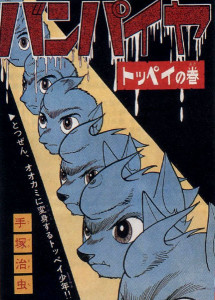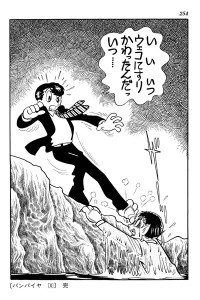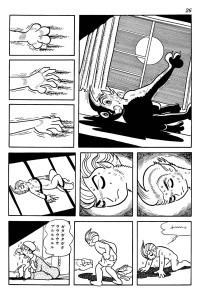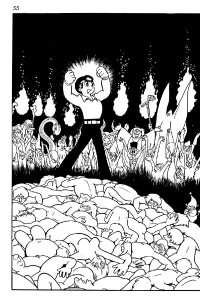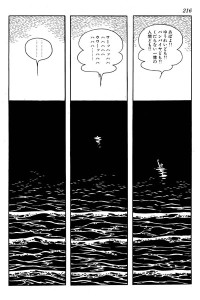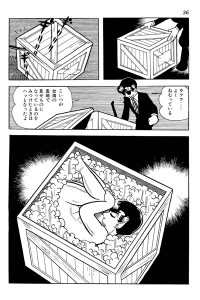Vampires (Manga)
Also known as バンパイヤ (Banpaiya)
| English Title: | Vampires |
| In English? | No |
| Japanese Title: | バンパイヤ (Banpaiya) |
| Type: | Ongoing Serial |
| Original run: Second run: |
1966/06/12 – 1967/05/07 1968/10 – 1969/04 |
| Published in: | Weekly Shonen Sunday 週刊少年サンデー Shonen Book 少年ブック |
| Published by: | Shogakukan Shueisha |
| Volumes: | 4 (MT-142 | MT-143 MT-144 | MT-320) |
A major turning point in Tezuka’s work, the Vampires (1966-69) manga series was originally published in Weekly Shonen Sunday between June 1966 to May 1967, with a sequel appearing in Shonen Book from October 1968 and ending abruptly, mid-story, in April 1969. The series also spawned a live-action television series, with animated animal versions of the vampires in 1969.
What it’s about (Part 1)
One morning, a strange boy named Toppei, who is actually a “vampire” who can transform himself into a wolf, shows up on the doorstep of an animation company called Mushi Productions. He convinces the president of the company, Osamu Tezuka, to hire him, however his real motive for coming to Tokyo is to search for his long-lost father. After discovering Toppei‘s secret, Tezuka consults with an old friend, Professor Atami, a world-renowned expert on the occult. However, after Atami perishes by falling off a cliff after provoking Toppei to transform into a wolf, the pair run afoul of cross-dressing black-mail artist and ne’er-do-well, Makube Rokuro. Rokuro blackmails Tezuka with the threat of revealing his role in Atami’s death into introducing him to Toppei. After a brief scuffle, Rokuro saves Toppei‘s life and, leveraging his debt, sends him on a mission to kidnap a young girl named Mika Onishi.
Despite his misgivings, Toppei kidnaps Mika only to discover that Rokuro is actually a young student taken in by the Onishi family. Manipulating events on both side of the equation, Rokuro is able to send Toppei to collect a sizeable ransom in diamonds from Mika’s parents. During the ransom escape, Toppei finds his missing father and learns that he is involved in the planning of a vampire revolution. However, the police soon catch up to Toppei, and his father is killed as they flee.
Meanwhile, Osamu Tezuka follows Rokuro and uncovers his plan to dispose of Mika Onishi permanently by abandoning her in an underground cavern. Rokuro discovers Tezuka following him and chases him deep into the cavern as well. There Tezuka stumbles upon a large population of shape-shifting vampires, however, luckily he crosses paths with Toppei once again, allowing Tezuka to escape his captors. However he soon crosses paths with Rokuro and ends up plunging over a cliff to his apparent death. Believing the last obstacle removed, Rokuro then manipulates Mika’s father into signing over the family wealth to him before orchestrating his death in a car crash – leaving Rokuro in control.
Now wealthy, Rokuro sets his plans for world domination in motion. Setting up a safe-haven for the vampires from which to stage their revolution, Rokuro becomes irreplaceable to the cause by destabilizing the government through a series of coordinated attacks. Using the vampires to covertly deliver his special “exploding pills”, Rokuro sows panic as high-level political figures begin exploding for no particular reason. This gives the vampires the opportunity they need to take control of the country – with Rokuro at its head.
However, all is not lost. Returning once again to the late Professor Atami’s estate, Toppei and Osamu Tezuka discover the secret of the “Mad P.A.”, a drug which, when administered, locks the vampires into their animal forms – with the associated level of consciousness. Armed with the Mad P.A., infiltrate the vampires headquarters and stop the revolution in its tracks. In the ensuing battle, Rokuro floats out to sea, never to be seen again…
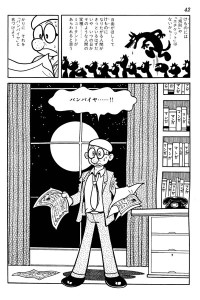
Osamu Tezuka discovers the truth
What it’s about (Part 2)
…until Vampires (1966-69) Part 2! Returning to his mansion headquarters, Rokuro discovers the aftermath of the failed vampire revolution. However, he has brought with him a creature known as a weco with him. Having captured the weco in Taiwan during his stay abroad, Rokuro is once again setting plans in motion in his quest for power. Unlike the vampires, which are basically humans that transform into animals, weco are cat-like creatures that feed on the blood of other animals and can transform into a human as a form of self-defense – in effect reverse vampires.
Although several stories from the Edo period, detailing previous human/weco interactions, are interspersed with the action, the main plot follows Rokuro‘s plot to take control of the Hiyama Group family conglomerate. To that end, Rokuro begins subjecting the weco to a harsh period of training, attempting to teach it to transform itself into the likeness of Hayato, the son of the company president. He then captures Hayato and, using his old tricks, traps him in a cave by dynamiting the entrance and causing a landslide. Although Rokuro believes him dead, Hayato escapes through a small adjacent tunnel, losing his memory in the process. Taken in by a kindly farmer, Hayato falls into a comfortable country life. However, learning that Hayato is still alive, Rokuro sends Weco to finish the job. During the struggle, Hayato recovers from his amnesia, overcomes Weco and decides to take his place at Rokuro‘s side. There he learns for Rokuro‘s plan to breed the weco and use them, once again, in a plot for world domination.
Despite being fooled by Hayato, Rokuro soon spots Weco and realizes he’s been had. And so, luring Hayato to yet another cave he pushes Hayato into an underground pool of water. Yet, much to Rokuro‘s surprise, what emerges from the pool is another weco, who pounces on him…
…and with that Shonen Book suddenly suspended publication. Since Tezuka never returned to finish the story, it ends on the cliffhanger.
What you should know
Despite it’s title, Vampires (1966-69), many readers are confused by the fact that it seems, instead, to be about werewolves. The story begins in a village of vampires who are destroying their homes and setting out into the world because humans are moving into their valley. Yet these “vampires” do not drink blood, nor are they immortal. Instead they all transform into animals, ranging from wolves and bats to snakes and crocodiles, and in each case the transformation is triggered by different stimuli. For example, while Toppei turns into a wolf when he sees the moon or when he is scared, his little brother Chippei transforms into a wolf whenever he sees anything round. Others vampires transform at the smell of onions, the sight of a telephone pole, or a wide range of other stimuli.
So why, then, does Tezuka call them vampires?
Luckily, Tezuka seems to provide the answer to that question in the story itself. Long ago, he says, before society developed, man was just another savage animal, fighting, killing and eating his fellow men freely in a chaotic, free-for-all. Then, with the advent of civilization, man developed a conscience, morals and laws to restrain him, while the beasts remained savage. The vampires are special creatures who, while human, have remained, like the beasts, free from the constraints of society and conscience – semi-humans symbolized by their animal transformations.
They are vampires, then, because they can prey upon men, not drinking blood specifically but regarding humans as potential prey, just as animals do.
In the course of the story, the vampires, spread all throughout the world, work toward a revolution in which they will overthrow human society and let men live as beasts again, free from moral constraints against evil, as the vampires do. Human society turns out to be filled with vampires who have been concealing their bestial nature for many generations, and are desperate for a chance to express themselves at last. It is the story of this revolution, and of the few humans and werewolves who oppose it, which is the focus of the first part of Vampires (1966-69).
However, in the second part of Vampires (1966-69), Tezuka presents us with opposites of vampires, the weco.
Whereas Vampires are basically humans who can become beasts, the weco are animals that can become human. The weco are strange cat-like beings, who originated in China, spread around the world, but who are now on the verge of extinction, with the power to transform into shape of any human being it sees – even mimicking human speech. Unlike the vampires, the weco do feed on blood, be it human or animal. While they are not naturally aggressive, and use their mimicking ability only as a survival mechanism to evade predators by pretending to be one of them, they are willing to kill when necessary.
It is this ability, and similarly that of the vampires, that make them ideal for exploitation by an evil mastermind like Makube Rokuro.
Although Vampires (1966-69) is one continuous story, Part 2 introduces stories set in different time periods. Although the modern-day plot-line, set just following the events in Part 1, makes up the bulk of the story, Tezuka also introduces other stories, set long before, in samurai times, that show earlier encounters between humans and the weco – in particular between Rock and the weco.
According to Tezuka, the weco are responsible for the traditional Japanese legends of female cat-demons. The repeated encounters between Rock and the weco, and their repeated, inevitable, adversarial relationship, makes it clear that Rock has a special relationship with transforming creatures, not just in his role as Rokuro but in many lives. This naturally leads to comparisons of Rock’s relationships with other transforming creatures in other series – particularly with the Moopies in the “Future” chapter of Phoenix (1967-88). These repeated encounters, over multiple incarnations, also go some way in explaining Rock’s strange confidence in places, particularly when he prophecies his own return in the face of what seems to be certain death. He will return to try again, death after death.
In the modern-day plot-line, Makube Rokuro is approached by a man who, having studied the weco, hopes that, given Rokuro‘s special affinity with the vampires, he will have a similar capacity to command the weco… which, indeed, he does.
Rokuro, as one would expect, plots to use the few surviving weco for his own criminal advancement, much as he did with the vampires, and he ends up capturing one and training it to be his doppleganger assassin. At first contact, the weco takes on Rokuro‘s form – eerily similar to the way the clay-like Ruborooms did in The Adventure of Rock (1952-54) – and this is followed by a chilling sequence of Rokuro torturing a beast in his own likeness, training it to behave like a man, “I will create a human out of you”.
The weco, meanwhile, are concerned only with saving themselves and preserving their species in the face of extinction. In this aspect, Vampires is one of many Tezuka works asking the question of whether two separate intelligent races can coexist – alongside stories such as Next World (1951), The Adventure of Rock (1952-54), Astro Boy (1952-68), Captain Ken (1960-61), Zero Men (1959-60), and others. What makes this case unique is that in no other case have the two races been quite so similar – the weco literally becoming human as they transform. Furthermore, Rokuro‘s evil exploitation differentiates Vampires (1966-69) from Tezuka’s other works where human/alien relations tend to degenerate into war without any primary villain.
So what makes Makube Rokuro so powerful?
One possible interpretation of Rokuro’s power over the vampires and weco is that, like his Shakespearean namesake, Macbeth, he is a king, albeit a king of transformation. This is an interesting possibility when you consider Tezuka’s focus on the earth as constantly transforming.
Another possibility is that he is simply some fourth, neither human, vampire nor weco, type of creature whose nature was not fully explored. Unfortunately, as the work remains unfinished, we do not know whether Rokuro finally succeeds in using his transforming minions to become king, as prophesied by the three witches, or whether he is defeated, as he is in so many other incarnations in this and other stories. We also do not know whether the two races, humans and weco, end up coexisting, destroying one another, or separating – all possibilities played out in other Tezuka series.
Whichever the case, Tezuka’s new focus on the charisma of evil continues throughout his later works, and “Dark Rock” appears in many more stories, carrying with him the central issue of Vampires (1966-69) – the freedom to do evil.
For more on the transformation of Rock Holmes, check out this great analytical essay by our own Ada Palmer.

